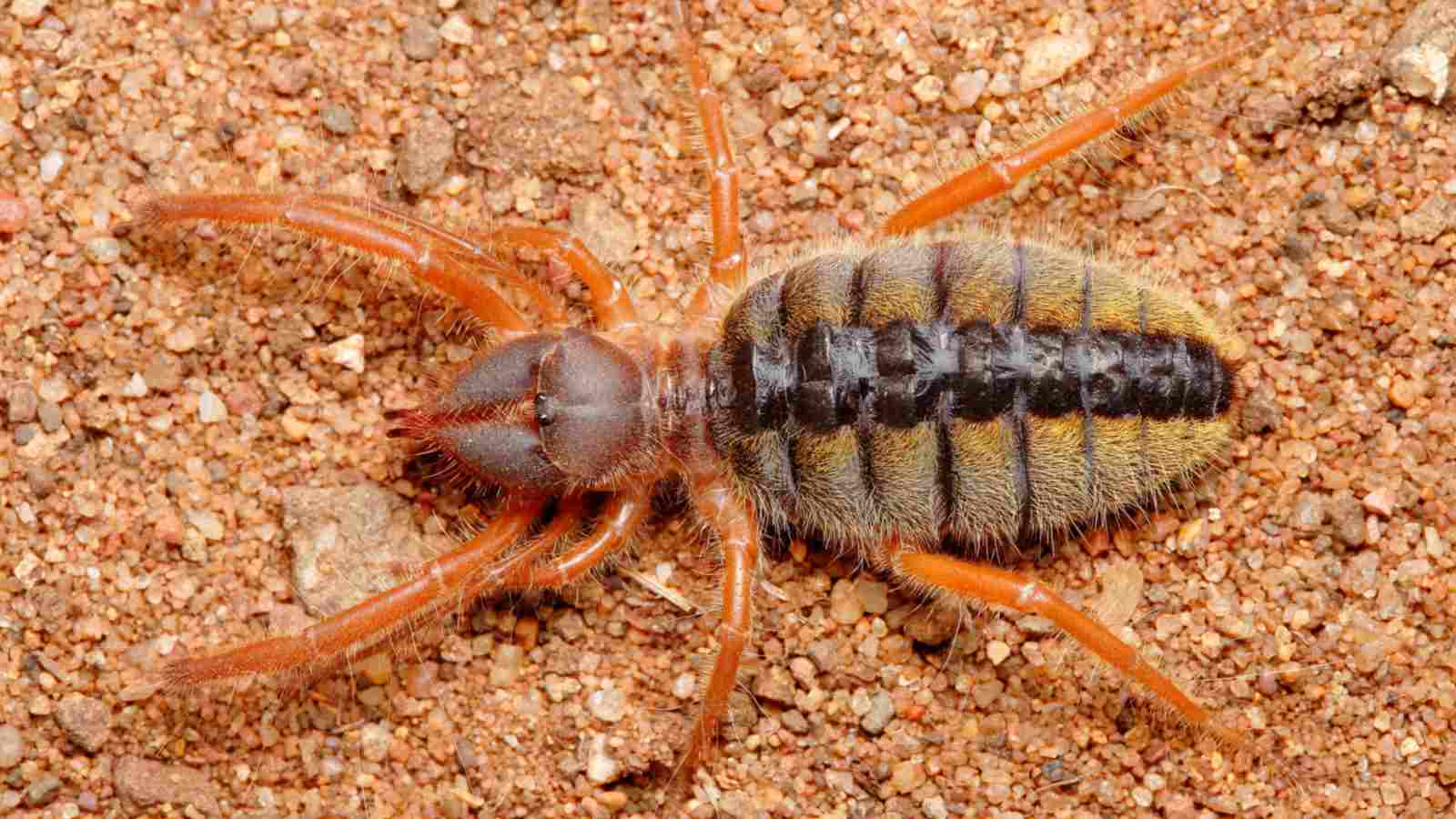
Are camel spiders really as terrifying as they seem? These desert-dwelling arachnids, often mistaken for true spiders, have sparked countless myths and urban legends. Known for their large size, hairy bodies, and powerful jaws, camel spiders can appear quite intimidating. However, much of their fearsome reputation is based on misinformation. Found in hot, arid regions like the Middle East and southwestern United States, these creatures are nocturnal hunters that play a crucial role in their ecosystems. Despite their scary looks, camel spiders are fascinating and misunderstood creatures. Let's dive into 35 intriguing facts that will help clear up the myths and reveal the truth about these unique arachnids.
Key Takeaways:
- Camel spiders, also known as solifugids, are fascinating creatures found in desert environments. Despite their fearsome appearance, they are not venomous and do not pose a threat to humans.
- These arachnids are nocturnal hunters with a diverse diet, feeding on insects, lizards, and small birds. They are adapted to thrive in harsh desert climates and are not as large or dangerous as some myths suggest.
What Are Camel Spiders?
Camel spiders, also known as solifugids, are intriguing creatures that have sparked curiosity and fear. Despite their fearsome reputation, they are often misunderstood. Let's dive into some fascinating facts about these desert dwellers.
-
Scientific Classification
Camel spiders belong to the class Arachnida but are not true spiders. They are part of the order Solifugae, which means "those who flee from the sun" in Latin. -
Common Names
Camel spiders are also called wind scorpions or Egyptian giant solpugids. These names reflect their desert habitats and impressive size. -
Appearance
With eight legs and two front appendages called pedipalps, camel spiders look large and hairy. They can grow up to 6 inches long and weigh about 2 ounces.
Where Do Camel Spiders Live?
These arachnids are adapted to thrive in some of the harshest environments on Earth. Their habitat preferences are as unique as their appearance.
-
Habitat
Camel spiders are found in dry, hot climates like deserts in the Middle East, Mexico, and the southwestern United States. They prefer scrublands and arid environments. -
Nocturnal Behavior
Being nocturnal, camel spiders are most active at night. During the day, they seek shade to avoid the intense sunlight. -
Desert Adaptation
They have adapted to desert life by breathing through a trachea, allowing for fast oxygen intake and quick movement, crucial for survival in arid environments.
What Do Camel Spiders Eat?
Camel spiders are carnivores with a diverse diet. Their feeding habits are as fascinating as their hunting techniques.
-
Diet
These arachnids feed on insects, lizards, small birds, rodents, and snakes. They use their powerful jaws (chelicerae) to seize and liquefy their prey before consuming it. -
Feeding Mechanism
Camel spiders use their chelicerae to chop or saw their prey into pulp. They then use digestive fluids to liquefy the flesh, making it easier to suck into their stomachs. -
Nocturnal Hunting
At night, camel spiders are active hunters. They use their speed and powerful jaws to catch their prey, which includes insects, lizards, and small birds.
How Fast Are Camel Spiders?
Speed is one of the most remarkable traits of camel spiders. Their ability to move quickly is essential for both hunting and avoiding predators.
-
Speed
Camel spiders can move quickly, reaching speeds of up to 10 miles per hour. This speed is impressive for an arachnid but not as fast as some other desert creatures. -
Shade Seeking
During the day, camel spiders seek shade to avoid the intense sunlight. They will often chase the shadow of a moving person to find cooler areas.
Myths and Misconceptions
Camel spiders have been the subject of many myths and misconceptions. Let's clear up some of the most common ones.
-
Myth Debunking
One enduring myth is that camel spiders eat the insides of camels' stomachs. This is entirely false; they are too small to subdue a large mammal like a camel. -
No Venom
Contrary to popular belief, camel spiders do not produce venom. Their bites are painful but not deadly to humans. The pain comes from their sharp chelicerae. -
Bite Injuries
If a camel spider bites a human, it can cause a painful wound. The risk of infection is higher if the wound is not properly treated. -
Internet Sensation
During the Iraq War in 2003, camel spiders became an internet sensation due to exaggerated stories and photos circulating online. These photos often showed the spiders as much larger than they actually are. -
False Perspective Photos
Photos that show camel spiders as large as human legs are misleading. The spiders are often placed in the foreground, making them appear much bigger than their actual size.
Species and Diversity
There are many species of camel spiders, each with unique characteristics. Their diversity is as vast as the deserts they inhabit.
-
Species Diversity
There are over 1,100 species of camel spiders, each with unique traits and habitats. Some species are larger than others, but all share common traits as arachnids and desert dwellers. -
Galeodes arabs
One well-known species is Galeodes arabs, found in the Middle East. This species is often called the Egyptian giant solpugid. -
Eremobates pallipes
Another notable species is Eremobates pallipes, found in the southwestern United States. This species thrives in hot desert environments.
Behavior and Defense
Camel spiders have unique behaviors and defense mechanisms that help them survive in their harsh environments.
-
Defensive Behavior
When threatened, camel spiders may hiss or display other defensive behaviors. However, most species do not make any sound. -
Nocturnal Attraction to Light
At night, camel spiders are attracted to light sources. This behavior is likely due to their nocturnal nature and the need to hunt under the cover of darkness. -
Burrowing Behavior
Some species burrow into sandy or rocky ground to escape the heat and find shelter. These burrows can be complex and provide protection from predators. -
Nocturnal Burrowing
At night, camel spiders may emerge from their burrows to hunt for prey. Their nocturnal behavior allows them to avoid the intense sunlight during the day.
Camel Spider Myths
Several myths surround camel spiders, including claims that they run after humans, scream, or eat people while they sleep. These myths are entirely false and have been debunked by experts.
-
Camel Spider Bite Pain
The bite of a camel spider is painful but not deadly. The pain is due to the sharp chelicerae that can cause significant injury. It is advisable to treat any wound caused by a camel spider bite promptly to avoid infection. -
Camel Spider Size Comparison
While camel spiders appear large, they are actually quite small compared to other arachnids. The largest species can grow up to 6 inches long, but most are much smaller. -
Camel Spider Speed Comparison
Camel spiders are fast runners, but their speed is relative to other arachnids. They can run up to 10 miles per hour, which is impressive for their size but not as fast as some other desert creatures. -
Camel Spider Diet Variety
Camel spiders are opportunistic predators and feed on a variety of prey including insects, lizards, small birds, and rodents. Their diet is diverse and reflects their adaptability to different environments. -
Camel Spider Feeding Mechanism
Camel spiders use their powerful jaws (chelicerae) to chop or saw their prey into pulp. They then utilize digestive fluids to liquefy the flesh, making it easier to suck into their stomachs. -
Camel Spider Nocturnal Hunting
At night, camel spiders are active hunters. They use their speed and powerful jaws to catch their prey, which includes insects, lizards, and small birds. -
Camel Spider Defensive Behavior
When threatened, camel spiders may hiss or display other defensive behaviors. However, most species do not make any sound. -
Camel Spider Conservation Status
Camel spiders are not evaluated on the IUCN Red List, and their current population trend is unknown. However, they are generally not considered to be a threatened species due to their widespread distribution and adaptability to different environments. -
Camel Spider Myths
Several myths surround camel spiders, including claims that they run after humans, scream, or eat people while they sleep. These myths are entirely false and have been debunked by experts. -
Camel Spider Bite Pain
The bite of a camel spider is painful but not deadly. The pain is due to the sharp chelicerae that can cause significant injury. It is advisable to treat any wound caused by a camel spider bite promptly to avoid infection. -
Camel Spider Size Comparison
While camel spiders appear large, they are actually quite small compared to other arachnids. The largest species can grow up to 6 inches long, but most are much smaller. -
Camel Spider Speed Comparison
Camel spiders are fast runners, but their speed is relative to other arachnids. They can run up to 10 miles per hour, which is impressive for their size but not as fast as some other desert creatures.
Fascinating Creatures of the Desert
Camel spiders, or solifugids, are truly intriguing arachnids. Despite their fearsome reputation, they play a vital role in desert ecosystems. These creatures, with their eight legs and powerful chelicerae, are efficient nocturnal hunters. They thrive in hot, arid environments, from the Middle East to the southwestern United States.
Many myths surround camel spiders, but they don't produce venom or pose a significant threat to humans. Their bites can be painful, yet they're not deadly. These arachnids are fast, reaching speeds up to 10 miles per hour, and are adept at seeking shade during the day.
Understanding camel spiders helps dispel misconceptions and appreciate their role in nature. They are not the monstrous creatures often portrayed but fascinating predators that contribute to the balance of their ecosystems. So next time you hear about camel spiders, remember these facts and see them in a new light.
Frequently Asked Questions
Was this page helpful?
Our commitment to delivering trustworthy and engaging content is at the heart of what we do. Each fact on our site is contributed by real users like you, bringing a wealth of diverse insights and information. To ensure the highest standards of accuracy and reliability, our dedicated editors meticulously review each submission. This process guarantees that the facts we share are not only fascinating but also credible. Trust in our commitment to quality and authenticity as you explore and learn with us.


